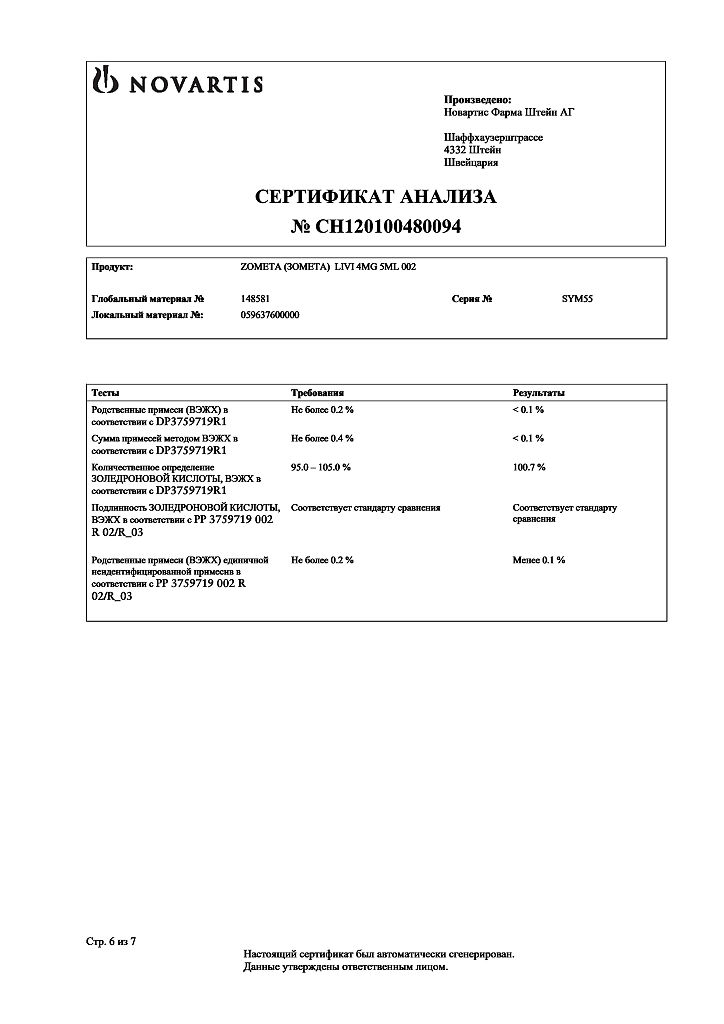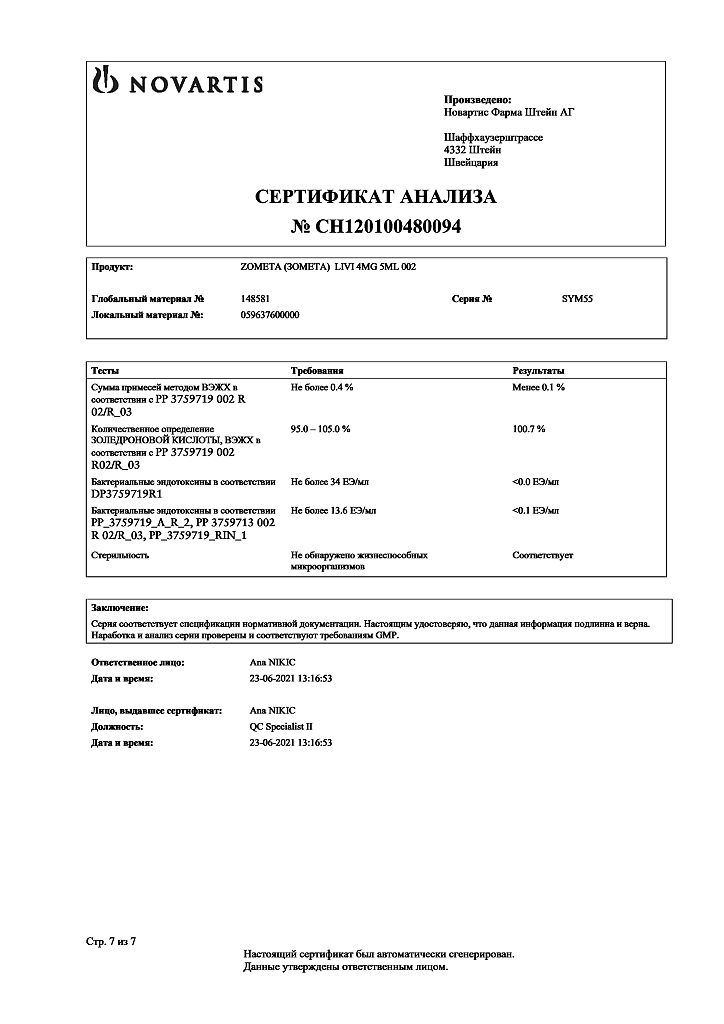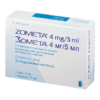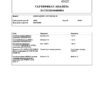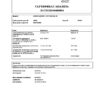No products in the cart.
Zometa, 4 mg/5 ml 5 ml
€1.00
Out of stock
(E-mail when Stock is available)
Description
Zometa is a bone resorption inhibitor.
Pharmacodynamics
Zoledronic acid refers to highly effective bisphosphonates with a selective effect on bone. The drug suppresses bone resorption by acting on osteoclasts.
The selective action of bisphosphonates on bone tissue is based on the high affinity for mineralized bone tissue. The exact molecular mechanism providing inhibition of osteoclast activity is still unclear. Zoledronic acid has no undesirable effect on bone formation, mineralization and mechanical properties.
In addition to its inhibitory effect on bone resorption, zoledronic acid has antitumor properties that make the drug effective in bone metastases:
in vivo: inhibition of osteoclastic bone resorption, altering the bone marrow microenvironment, resulting in reduced tumor cell growth; anti-angiogenic activity. Suppression of bone resorption is clinically accompanied by a pronounced reduction of pain sensations.
In vitro: inhibition of osteoblast proliferation, direct cytotoxic and pro-apoptotic activity, synergistic cytostatic effect with antitumor drugs; anti-adhesive/anti-invasive activity.
Zoledronic acid, by inhibiting proliferation and inducing apoptosis, has a direct antitumor effect against human myeloma cells and breast cancer cells, and also reduces penetration of breast cancer cells through the extracellular matrix, indicating that it has antimetastatic properties. In addition, zoledronic acid inhibits proliferation of human and animal endothelial cells and has anti-angiogenic effect.
In patients with breast cancer, prostate cancer and other solid tumors with metastatic bone involvement Zometa prevents development of pathological fractures, spinal cord compression, reduces the need for radiation therapy and surgical interventions, reduces tumor hypercalcemia.
The drug is able to inhibit the progression of pain syndrome. The therapeutic effect is less pronounced in patients with osteoblastic foci than in osteolytic ones. In patients with multiple myeloma and breast cancer with at least one bone focus the efficacy of Zometa at a dose of 4 mg is comparable with pamidronate at a dose of 90 mg.
In patients with tumor hypercalcemia the effect of Zometa is characterized by a decrease in serum calcium levels and urinary calcium excretion. The average time to normalization of calcium levels is about 4 days. By day 10, calcium concentrations normalize in 87-88% of patients.
The average time to relapse (albumin-corrected serum calcium level of at least 2.9 mmol/L) is 30-40 days. There are no significant differences between the efficacy of Zometa at doses of 4 and 8 mg in the treatment of hypercalcemia.
The studies show no significant differences in the frequency and severity of adverse events observed in patients treated with Zometa at doses of 4 or 8 mg, pamidronate at 90 mg, or placebo in both the treatment of bone metastases and hypercalcemia.
Pharmacokinetics
Pharmacokinetic data for bone metastases were obtained after single and repeated 5- and 15-minute infusions of 2, 4, 8, and 16 mg of zoledronic acid in 64 patients. Pharmacokinetic parameters were independent of the drug dose.
After initiation of Zometa infusion, serum concentrations increase rapidly, peaking at the end of the infusion, followed by a rapid 10% decrease in concentration after 4 h and less than 1% after 24 h with a consistently prolonged period of low concentrations not exceeding 0.1% of maximum until repeat infusion on day 28.
Zoledronic acid administered by IV is excreted by the kidneys in 3 phases: a rapid biphasic excretion of the drug from the systemic circulation with T1/2 of 0.24 h and 1.87 h and a prolonged phase with a final T1/2 of 146 h. No drug cumulation was noted with repeated injections every 28 days.
Zoledronic acid is not metabolized systemically and is excreted unchanged by the kidneys. During the first 24 hours (39±16)% of the administered dose is detected in the urine. The remaining amount of the drug is mainly bound to the bone tissue.
Then slowly zoledronic acid is re-released from the bone tissue into the systemic bloodstream and excreted by the kidneys. Total plasma clearance of the drug is (5.04±2.5) l/h and is independent of the drug dose, sex, age, race and body weight of the patient. Increasing the infusion time from 5 to 15 min leads to a 30% decrease in zoledronic acid concentration at the end of infusion, but does not affect the AUC.
Pharmacokinetic studies have not been performed in patients with hypercalcemia or impaired liver function. According to the data received in vitro, zoledronic acid does not inhibit human P450 enzyme and does not undergo biotransformation, which suggests that hepatic function status does not influence zoledronic acid pharmacokinetics in any significant way. Less than 3% of the drug dose is excreted with the feces.
The renal clearance of zoledronic acid correlates positively with creatinine clearance and is (75±33)% of Cl creatinine reaching an average (84±29)% (range, 22-143 ml/min) in 64 patients enrolled in the study.
Population analysis showed that patients with a creatinine Cl of 20 mL/min (severe renal failure) or 50 mL/min (moderate renal failure) had a calculated zoledronic acid clearance of 37 and 72%, respectively, of the zoledronate clearance value in patients with a creatinine Cl of 84 mL/min. Limited pharmacokinetic data were obtained for patients with severe renal insufficiency (creatinine Cl
Low affinity of zoledronic acid for blood components was shown. Binding to plasma proteins is low (about 50%) and is independent of Zometa concentration.
Indications
Indications
Bone metastases of common malignant tumors (prostate cancer, breast cancer) and multiple myeloma, incl. to reduce the risk of pathological fractures, spinal cord compression, tumor-related hypercalcemia, and reduce the need for radiation therapy or bone surgery; hypercalcemia caused by a malignant tumor.
Pharmacological effect
Pharmacological effect
Zometa is a bone resorption inhibitor.
Pharmacodynamics
Zoledronic acid is a highly potent bisphosphonate that has a selective effect on bone. The drug suppresses bone resorption by acting on osteoclasts.
The selective effect of bisphosphonates on bone tissue is based on their high affinity for mineralized bone tissue. The exact molecular mechanism responsible for the inhibition of osteoclast activity still remains unclear. Zoledronic acid does not have undesirable effects on bone formation, mineralization, or mechanical properties.
In addition to the inhibitory effect on bone resorption, zoledronic acid has antitumor properties that ensure the effectiveness of the drug in bone metastases:
in vivo: inhibition of osteoclastic bone resorption, changing the microenvironment of the bone marrow, leading to a decrease in the growth of tumor cells; antiangiogenic activity. Suppression of bone resorption is clinically accompanied by a pronounced decrease in pain.
in vitro: inhibition of osteoblast proliferation, direct cytotoxic and proapoptotic activity, synergistic cytostatic effect with antitumor drugs; anti-adhesive/anti-invasive activity.
Zoledronic acid, by inhibiting proliferation and inducing apoptosis, has a direct antitumor effect against human myeloma cells and breast cancer, and also reduces the penetration of breast cancer cells through the extracellular matrix, which indicates the presence of antimetastatic properties. In addition, zoledronic acid inhibits the proliferation of human and animal endothelial cells and has an antiangiogenic effect.
In patients with breast cancer, prostate cancer and other solid tumors with metastatic bone lesions, Zometa prevents the development of pathological fractures, spinal cord compression, reduces the need for radiation therapy and surgical interventions, and reduces tumor hypercalcemia.
The drug is able to inhibit the progression of pain. The therapeutic effect is less pronounced in patients with osteoblastic lesions than in patients with osteolytic lesions. In patients with multiple myeloma and breast cancer with at least one bone lesion, the effectiveness of Zometa at a dose of 4 mg is comparable to pamidronate at a dose of 90 mg.
In patients with tumor hypercalcemia, the effect of Zometa is characterized by a decrease in the level of calcium in the blood serum and calcium excretion in the urine. The average time for calcium levels to normalize is about 4 days. By the 10th day, calcium concentration is normalized in 87–88% of patients.
The average time to relapse (albumin-corrected serum calcium level of at least 2.9 mmol/L) is 30–40 days. There are no significant differences between the effectiveness of Zometa in doses of 4 and 8 mg in the treatment of hypercalcemia.
The studies did not reveal significant differences in the incidence or severity of adverse events observed in patients receiving Zometa 4 or 8 mg, pamidronate 90 mg, or placebo for either bone metastases or hypercalcemia.
Pharmacokinetics
Pharmacokinetic data for bone metastases were obtained after single and repeated 5- and 15-minute infusions of 2, 4, 8 and 16 mg of zoledronic acid in 64 patients. Pharmacokinetic parameters do not depend on the dose of the drug.
After initiation of Zometa infusion, serum concentrations increase rapidly, reaching a peak at the end of the infusion, followed by a rapid decrease in concentration by 10% after 4 hours and by less than 1% after 24 hours, with a successively prolonged period of low concentrations not exceeding 0.1% of the maximum until re-infusion on the 28th day.
Zoledronic acid administered intravenously is excreted by the kidneys in 3 stages: a rapid two-phase elimination of the drug from the systemic circulation with T1/2 of 0.24 hours and 1.87 hours and a long phase with a final T1/2 of 146 hours. No accumulation of the drug was observed with repeated administrations every 28 days.
Zoledronic acid does not undergo systemic metabolism and is excreted unchanged by the kidneys. During the first 24 hours, (39±16)% of the administered dose is detected in the urine. The remaining amount of the drug is mainly associated with bone tissue.
Zoledronic acid is then slowly released back from bone tissue into the systemic circulation and excreted by the kidneys. The total plasma clearance of the drug is (5.04 ± 2.5) l/h and does not depend on the dose of the drug, gender, age, race and body weight of the patient. Increasing the infusion time from 5 to 15 minutes resulted in a 30% decrease in zoledronic acid concentration at the end of the infusion but had no effect on AUC.
Pharmacokinetic studies have not been conducted in patients with hypercalcemia or liver failure. Based on in vitro data, zoledronic acid does not inhibit the human P450 enzyme and is not biotransformed, suggesting that the state of liver function does not significantly affect the pharmacokinetics of zoledronic acid. Less than 3% of the drug dose is excreted in feces.
Renal clearance of zoledronic acid correlates positively with creatinine clearance and accounts for (75±33)% of creatinine Cl, reaching an average of (84±29)% (range 22–143 ml/min) in 64 patients included in the study.
A population analysis showed that in patients with a creatinine Cl of 20 ml/min (severe renal failure) or 50 ml/min (moderate renal failure), the calculated clearance of zoledronic acid was 37 and 72%, respectively, of the clearance of zoledronate in patients with a creatinine Cl of 84 ml/min. Limited pharmacokinetic data have been obtained in patients with severe renal impairment (Cl creatinine
Zoledronic acid has been shown to have a low affinity for blood components. Plasma protein binding is low (about 50%) and does not depend on the concentration of Zometa.
Special instructions
Special instructions
Use for liver dysfunction. Since there are limited clinical data on the use of the drug in patients with severe liver failure, it is not possible to make specific recommendations for this category of patients.
Use for renal dysfunction. When deciding on the use of Zometa in patients with hypercalcemia caused by a malignant tumor, against the background of impaired renal function, it is necessary to assess the patient’s condition and conclude whether the potential benefit of administering the drug outweighs the possible risk.
Before each administration of Zometa, the serum creatinine concentration should be determined. At the beginning of treatment with the drug in patients with bone metastases and with mild to moderate renal dysfunction, it is recommended to use Zometa in reduced doses.
In patients who develop renal impairment during Zometa therapy, drug therapy can be continued only after the creatinine concentration returns to values that are within 10% of the initial value.
Considering the possibility of renal dysfunction when using bisphosphonates, incl. Zometa, as well as due to the lack of comprehensive data on the clinical safety of the drug in patients with severely impaired renal function (serum creatinine concentration ≥400 µmol/l or ≥4.5 mg/dl – in patients with hypercalcemia caused by a malignant tumor and ≥265 µmol/l or ≥3.0 mg/dl – in patients with malignant tumors with bone metastases) and the presence very limited pharmacokinetic data in patients with initial severe renal impairment (Cl creatinine ≤30 ml/min), the use of Zometa in this group of patients is not recommended.
Before infusion, ensure that the patient is adequately hydrated. If necessary, it is recommended to administer saline before, in parallel or after the infusion of Zometa. Overhydration of the patient should be avoided due to the risk of cardiovascular complications.
After administration of Zometa, constant monitoring of the concentrations of calcium, phosphorus, magnesium and creatinine in the blood serum is necessary. If hypocalcemia, hypophosphatemia or hypomagnesemia develops, short-term additional administration of the corresponding substances may be necessary. Patients with untreated hypercalcemia usually have impaired renal function, so careful monitoring of renal function in this category of patients is necessary.
When deciding whether to treat patients with bone metastases with Zometa in order to reduce the risk of pathological fractures, spinal cord compression, tumor-related hypercalcemia, and reduce the need for radiation therapy or bone surgery, it should be taken into account that the therapeutic effect occurs 2-3 months after the start of Zometa treatment.
There are isolated reports of renal dysfunction associated with the use of bisphosphonates. Risk factors for such complications include dehydration, previous renal failure, repeated administration of Zometa or other bisphosphonates, as well as the use of nephrotoxic drugs, and too rapid administration of the drug.
Despite the fact that the risk of the above-described complications is reduced if Zometa is administered at a dose of 4 mg for at least 15 minutes, the possibility of impaired renal function remains.
There have been cases of deterioration in renal function, progression of renal failure and the need for hemodialysis with the first or single use of Zometa.
Increases in serum creatinine concentrations have also been observed in some patients with long-term use of Zometa at recommended doses, although less frequently.
Since there are limited clinical data on the use of the drug in patients with severe liver failure, it is not possible to make specific recommendations for this category of patients.
Cases of osteonecrosis of the jaw have been described in cancer patients during antitumor treatment, including bisphosphonates (including Zometa). Many patients had signs of a local infectious and inflammatory process, including osteomyelitis.
In clinical practice, the development of osteonecrosis of the jaw was most often observed in patients with advanced breast cancer and multiple myeloma, as well as in the presence of dental diseases (including after tooth extraction, periodontal diseases, unsatisfactory fixation of dentures).
Known risk factors for osteonecrosis of the jaw are: cancer, cancer-related treatment (including chemotherapy, radiation therapy, corticosteroids), concomitant diseases (including anemia, coagulopathy, infection, pre-existing oral disease).
Before prescribing bisphosphonates, patients with cancer should undergo a dental examination and appropriate preventive procedures, and recommend strict adherence to good oral hygiene.
Dental surgery should be avoided if possible during treatment of these patients. There is no evidence that interrupting bisphosphonate treatment before dental procedures reduces the risk of osteonecrosis of the jaw. The treatment plan for a particular patient should be based on an individual assessment of the risk/benefit ratio.
In clinical practice, rare cases of severe and in some cases disabling pain in bones, joints and muscles have been reported with the use of bisphosphonates, which include zoledronic acid.
These symptoms developed over a period of 1 day to several months from the start of treatment. Symptoms resolved in most patients after stopping treatment. In several patients, symptoms recurred when therapy was restarted or another bisphosphonate was prescribed.
Zometa contains the same active ingredient as Aklasta – zoledronic acid. Patients receiving Zometa therapy should not receive Aklasta at the same time.
Use in pediatrics. The effectiveness and safety of Zometa in pediatric practice have not yet been established.
Impact on the ability to drive vehicles and operate machinery
The effect of Zometa on the ability to drive vehicles and operate machinery has not been studied.
Active ingredient
Active ingredient
Zoledronic acid
Composition
Composition
Active ingredient:
zoledronic acid monohydrate;
Excipients:
mannitol,
sodium citrate,
water for injections,
nitrogen
Pregnancy
Pregnancy
Zometa is contraindicated for use during pregnancy and lactation (breastfeeding).
Contraindications
Contraindications
hypersensitivity to zoledronic acid, other bisphosphonates and other components of the drug;
pregnancy;
lactation period (breastfeeding).
Side Effects
Side Effects
From the hematopoietic organs: often – anemia, sometimes – thrombocytopenia, leukopenia; rarely – pancytopenia.
From the peripheral nervous system and central nervous system: often – headache; sometimes – dizziness, paresthesia, taste disturbances, hypoesthesia, hyperesthesia, tremor, anxiety, sleep disorders; rarely – confusion.
From the organs of vision: often – conjunctivitis; sometimes blurred vision; very rarely – uveitis, episcleritis.
From the digestive system: often – nausea, vomiting, anorexia; sometimes – diarrhea, constipation, abdominal pain, dyspepsia, stomatitis, dry mouth.
From the respiratory system: sometimes – shortness of breath, cough.
Dermatological reactions: sometimes – itching, rash (including erythematous and macular), increased sweating.
From the musculoskeletal system: often – bone pain, myalgia, arthralgia, generalized pain; sometimes – muscle cramps.
From the cardiovascular system: sometimes – a pronounced increase or decrease in blood pressure; rarely – bradycardia.
From the urinary system: often – renal dysfunction; sometimes – acute renal failure, hematuria, proteinuria.
From the immune system: sometimes – hypersensitivity reactions; rarely – angioedema.
From laboratory parameters: very often – hypophosphatemia; often – increased serum concentrations of creatinine and urea, hypocalcemia; sometimes – hypomagnesemia, hypokalemia; rarely – hyperkalemia, hypernatremia.
Local reactions: pain, irritation, swelling, formation of infiltrate at the site of drug administration.
Other: often – fever, flu-like syndrome (including general malaise, chills, pain, fever), sometimes – asthenia, peripheral edema; chest pain, weight gain.
Interaction
Interaction
When used simultaneously with Zometa other commonly used drugs (antitumor drugs, diuretics, antibiotics, analgesics), no clinically significant interactions were observed.
According to data obtained in in vitro studies, zoledronic acid does not have significant binding to plasma proteins and does not inhibit enzymes of the cytochrome P450 system. However, specific clinical studies to study drug interactions have not been conducted.
Caution is recommended when using bisphosphonates and aminoglycosides concomitantly, since the simultaneous effect of these drugs is manifested by an increase in the duration of the decrease in plasma calcium concentrations.
Caution is necessary when using Zometa simultaneously with drugs that have a potentially nephrotoxic effect.
The possibility of developing hypomagnesemia should also be kept in mind.
In patients with multiple myeloma, there may be an increased risk of developing renal dysfunction when administered intravenously with bisphosphonates, such as Zometa, in combination with thalidomide.
Pharmaceutical interactions
A diluted Zometa solution should not be mixed with infusion solutions containing calcium ions (for example, Ringer’s solution).
When glass bottles, infusion systems and bags of various types made of PVC, polyethylene and polypropylene (pre-filled with 0.9% sodium chloride solution or 5% dextrose solution) were used to administer Zometa, no signs of incompatibility with Zometa were found.
Overdose
Overdose
Symptoms: in case of acute overdose of the drug (limited data), renal dysfunction (including renal failure), changes in electrolyte composition (including concentrations of calcium, phosphate and magnesium in the blood plasma) were noted.
A patient who has received the drug in a dose exceeding the recommended one should be under constant supervision.
Treatment: if hypocalcemia occurs with clinically significant manifestations, an infusion of calcium gluconate is indicated.
Storage conditions
Storage conditions
At a temperature not exceeding 30 °C
Shelf life
Shelf life
3 years
Manufacturer
Manufacturer
Novartis Pharma Stein AG, Switzerland
Additional information
| Shelf life | 3 years |
|---|---|
| Conditions of storage | At a temperature not exceeding 30 °C |
| Manufacturer | Novartis Pharma GmbH, Germany |
| Medication form | concentrate for preparation of infusion solution |
| Brand | Novartis Pharma GmbH |
Related products
Buy Zometa, 4 mg/5 ml 5 ml with delivery to USA, UK, Europe and over 120 other countries.



